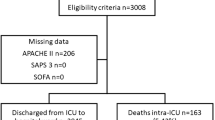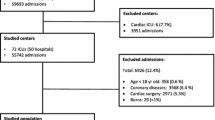Abstract
Objective
External validation of three prognostic models in adult intensive care patients in South England.
Design
Prospective cohort study.
Setting
Seventeen intensive care units (ICU) in the South West Thames Region in South England.
Patients and participants
Data of 16,646 patients were analysed.
Interventions
None.
Measurements and results
We compared directly the predictive accuracy of three prognostic models (SAPS II, APACHE II and III), using formal tests of calibration and discrimination. The external validation showed a similar pattern for all three models tested: good discrimination, but imperfect calibration. The areas under the receiver operating characteristics (ROC) curves, used to test discrimination, were 0.835 and 0.867 for APACHE II and III, and 0.852 for the SAPS II model. Model calibration was assessed by Lemeshow-Hosmer C-statistics and was Χ2 =232.1 for APACHE II, Χ2 =443.3 for APACHE III and Χ2 =287.5 for SAPS II.
Conclusions
Disparity in case mix, a higher prevalence of outcome events and important unmeasured patient mix factors are possible sources for the decay of the models' predictive accuracy in our population. The lack of generalisability of standard prognostic models requires their validation and re-calibration before they can be applied with confidence to new populations. Customisation of existing models may become an important strategy to obtain authentic information on disease severity, which is a prerequisite for reliably measuring and comparing the quality and cost of intensive care.

Similar content being viewed by others
Explore related subjects
Discover the latest articles and news from researchers in related subjects, suggested using machine learning.References
Le Gall JR, Lemeshow S, Saulnier F (1993) Development of a new scoring system, the SAPS II, from a European/North American multicenter study. JAMA 270:2957–2963
Knaus WA, Draper EA, Wagner DP et al. (1985) APACHE II: a severity of disease classification system. Crit Care Med 10:818–829
Knaus WA, Wagner DP, Draper EA et al. (1991) The APACHE III prognostic system: risk prediction of hospital mortality for critically ill hospitalized adults. Chest 100:1619–1639
Wong DT, Crofts SL, Gomez M, McGuire GP, Byrick RJ (1995) Evaluation of predictive ability of APACHE II system and hospital outcome in Canadian intensive care patients. Crit Care Med 23:1177–1183
Sirio CA, Tajimi K, Tase C, Knaus WA, Wagner DP, Hirasawa H et al. (1992) An initial comparison of intensive care in Japan and the United States. Crit Care Med 20:1207–1215
Markgraf R, Deutschinoff G, Pientka L, Scholten T (2000) Comparison of Acute Physiology and Chronic Health Evaluation score II and III and Simplified Acute Physiology Score II: a prospective cohort study evaluating these models to predict outcome in a German multidisciplinary intensive care unit. Crit Care Med 28:26–33
Castella X, Artigas A, Bion J, Kari A (1995) A comparison of severity of illness scoring systems for intensive care unit patients: results of a multicenter, multinational study. Crit Care Med 23:1327–1335
Apolone G, Bertolini G, D'Amico R, Iapichino G, Cattanco A, De Salvo G, Melotti RM (1996) The performance of SAPS II in a cohort of Italian ICUs: results from GiViTI. Intensive Care Med 22:1368–1378
Moreno R, Reis Miranda D, Fidler V, Van Schilfgaarde R (1998) Evaluation of two outcome prediction models on an independent database. Crit Care Med 26:50–61
Rowan KM, Kerr JH, Major E, Mc Pherson K, Short A, Vesssey MP (1993) Intensive Care Society's APACHE II study in Britain and Ireland II: outcome comparisons of intensive care units after adjustment for case mix by the American APACHE II method. BMJ 307:977–981
Zimmerman JE, Wagner DP, Draper EA et al. (1998) Evaluation of Acute Physiology and Chronic Health III predictions of hospital mortality in an independent database. Crit Care Med 20:1317–1326
Pappachan JV, Millar B, Bennett D, Smith GB (1999) Comparison of outcome from intensive care admission after adjustment for case mix by the APACHE III prognostic system. Chest 115:802–805
Bastios PG, Sun X, Wagner DP, Knaus WA, Zimmerman JE (1996) Application of the APACHE III prognostic system in Brazilian intensive care units: a prospective multicenter study. Intensive Care Med 22:564–570
Rowan KM, Kerr JH, Major E et al. (1994) Intensive Care Society's Acute Physiology and Chronic Health Evaluation (APACHE II) study in Britain and Ireland: a prospective, multicenter, cohort study comparing two methods for predicting outcome for adult intensive care patients. Crit Care Med 22:1392–1401
Livingston BM, MacKirdy FN, Howie JC, Jones R, Norrie JD (2000) Assessment of the performance of five intensive care scoring models within a large Scottish database. Crit Care Med 28:1820–1827
Beck DH, Taylor BL, Millar B, Smith GB (1997) Prediction of outcome from intensive care: a prospective cohort study comparing APACHE II and III in a UK intensive care unit. Crit Care Med 25:9–15
Hanley JA, McNeil BJ (1982) The meaning and use of the area under a receiver operating characteristic (ROC) curve. Radiology 143:29–36
Hosmer DW, Lemeshow S (1989) Applied logistic regression. John Wiley, New York, pp 135–149
Lemeshow S, Hosmer DW (1982) A review of the goodness of fit statistics for use in the development of logistic regression models. Am J Epidemiol 115: 92–106
Altman DC, Royston P (2000) What do we mean by validating prognostic models? Stat Med 19:453–473
Harrell FE, Lee K (1984) Regression modelling strategies for improved prognostic prediction. Stat Med 3:143–152
Goldhill DR, Withington PS (1996) The effect of case mix adjustment on mortality as predicted by APACHE II. Intensive Care Med 22:415–419
Rowan KM, Kerr JH, Major E et al. (1993) Intensive Care Society's APACHE II study in Britain and Ireland I: variations in case mix of adult admissions to general intensive care units and impact on outcome. BMJ 307:972–977
Moreno R, Apolone G, Reis Miranda D (1998) Evaluation of the uniformity of fit of general outcome prediction models. Intensive Care Med 24:40–47
Metnitz PGH, Vesely H, Valentin A, Popow C, Hiesmayr M, Lenz K, Krenn CG Steltzer H (1999) Evaluation of an interdisciplinary data set for national intensive care unit assessment. Crit Care Med 27:1486–1491
Murphy-Filkins RL, Teres D, Lemeshow S, Hosmer DW (1996) Effect of changing patient mix on the performance of intensive care unit severity-of-illness models: how to distinguish a general from a speciality intensive care unit. Crit Care Med 24:1968–1973
Lemeshow S, Teres D, Klar J et al. (1993) Mortality Probability Models (MPM II) based on an international cohort of intensive care unit patients. JAMA 270:2478–2486
Beck DH, McQuillan PJ, Smith GB (2002) Waiting for the break of dawn? The effects of discharge TISS scores, discharge time and discharge facilities on mortality after intensive care. Intensive Care Med 28:1287–1293
Miller ME, Hui SL, Tierney WM (1991) Validation techniques for logistic regression models. Stat Med 10:1213–1226
Zhu PG, Lemeshow S, Hosmer DW, Klar J, Avrunin J, Teres D (1996) Factors affecting the performance of the models in the Mortality Prediction Model II system and strategies of customization: a simulation study. Crit Care Med 24:57–63
Glance LG, Osler TM, Papadakos P (2000) Effect of mortality rate on the performance of the Acute Physiology and Chronic Health Evaluation II: a simulation study. Crit Care Med 28:3424–3428
Rivera-Fernandez R, Vazquez-Mata G, Bravo M, Aguayo-Hoyos E, Zimmerman JE, Wagner DP, Knaus WA (1998) The APACHE III prognostic system: customized mortality predictions for Spanish ICU patients. Intensive Care Med 24:574–581
Moreno R, Apolone G (1997) Impact of different customization strategies in the performance of a general severity score. Crit Care Med 25:2001–2008
Beck DH, Smith GB, Pappachan JV (2002) The effects of two methods for customising the original Simplified Acute Physiology Score (SAPS) II for intensive care patients from South England. Anaesthesia; 57:785–793
Sirio CA, Shepardson LB, Rotondi AJ, Cooper GS, Angus DC, Harper DL, Rosenthal GE (1999) Community-wide assessment of intensive care outcomes using a physiologically based prognostic measure. Chest 115:793–801
Teres D, Lemeshow S (1998) As American as apple pie and APACHE (editorial). Crit Care Med 26:1297–1298
Ridley S (2001) Critical care outcomes. Anaesthesia 56:1–3
Smith GB, Taylor BL, McQuillan PJ, Nials E (1995) Rationing intensive care: intensive care provision varies widely in Britain. BMJ 10:1412–1413
Metcalfe A, McPherson K. Sloggett A (1997) Mortality among appropriately referred patients refused admission to intensive care units. Lancet 350:7–11
Goldfrad C, Rowan K (2000) Consequences of discharges from intensive care at night. Lancet 355:1138–1142
Acknowledgements
We acknowledge the directors and staff of the following ICUs for their co-operation and enthusiasm in the collection of data for this study: Ashford Hospital, Middlesex; Crawley Hospital; East Surrey Hospital, Redhill; Epsom General Hospital; Frimley Park Hospital; Haywards Heath Hospital; Kingston Hospital; Mayday Hospital, Croydon; Queen Mary's Hospital, Roehampton; Royal Surrey County Hospital, Guildford; St. Helier Hospital, Carshalton; St. Peter's Hospital, Chertsey; St. Richard's Hospital, Chichester; Worthing Hospital; General ICU, St. George's Hospital, Tooting; Queen Alexandra Hospital, Portsmouth and St. Mary's Hospital, Portsmouth.
Author information
Authors and Affiliations
Corresponding author
Additional information
Work performed in the Department of Intensive Care Medicine, Portsmouth Hospitals NHS Trust, Queen Alexandra Hospital, Portsmouth PO6 3LY, Hampshire, UK.
Funding support: This study was supported by departmental funds. There was no conflict of interest.
Rights and permissions
About this article
Cite this article
Beck, D.H., Smith, G.B., Pappachan, J.V. et al. External validation of the SAPS II, APACHE II and APACHE III prognostic models in South England: a multicentre study. Intensive Care Med 29, 249–256 (2003). https://doi.org/10.1007/s00134-002-1607-9
Received:
Accepted:
Published:
Issue Date:
DOI: https://doi.org/10.1007/s00134-002-1607-9




